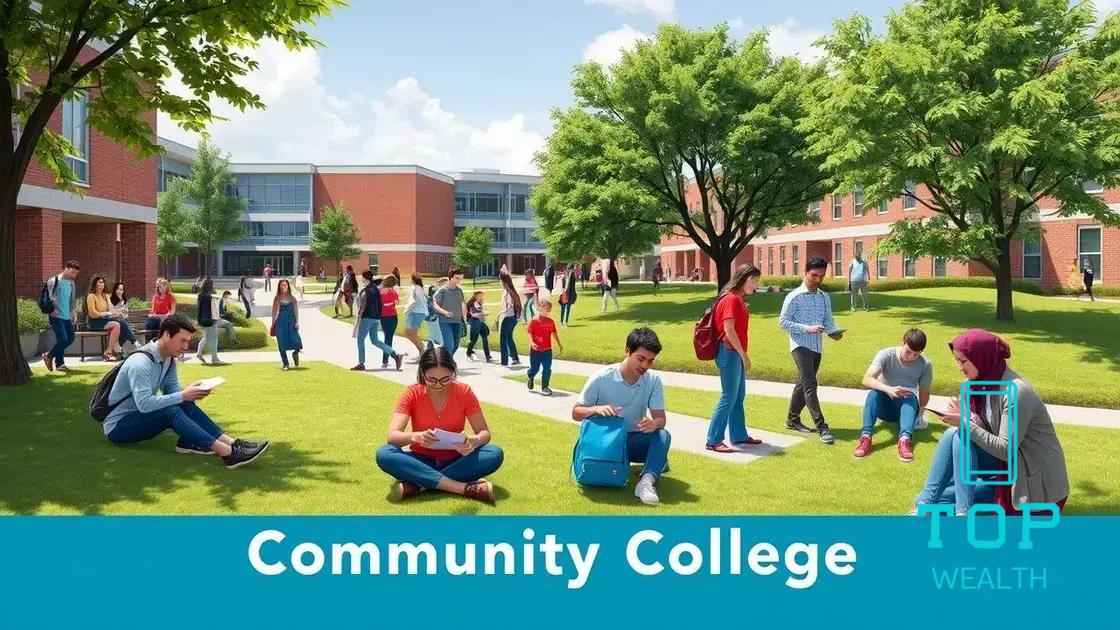Community colleges gain attention through policy reform

Community colleges gain attention through policy reform by providing affordable education, aligning programs with workforce needs, and enhancing student support, all of which contribute to increased enrollment and graduation rates.
Community colleges gain attention through policy reform, transforming the landscape of higher education. Have you ever wondered how these institutions are adapting to meet new demands? Let’s dive into the significant changes underway.
Understanding the impact of policy reforms
Understanding the impact of policy reforms on community colleges is essential for grasping their role in modern education. These reforms are changing how these institutions operate, making education more accessible to students from various backgrounds.
Key Changes in Policy Reforms
Many new policies aim to strengthen community colleges. For instance, funding has been directed towards improving facilities and expanding programs. This ensures that schools not only meet current educational needs but also prepare for future demand.
- Increased funding for educational programs
- Stronger partnerships with local businesses
- Enhanced support services for students
- New pathways for job training and certifications
Each of these changes has a direct impact on students. Enhanced funding allows schools to hire better faculty and invest in technology, which leads to a more effective learning environment.
Benefits of Increased Accessibility
With policy reforms focusing on accessibility, more students are enrolling in community colleges. This surge helps diversify the student body, creating a richer educational experience. More programs mean that students can find courses that fit their career goals.
Additionally, these reforms support students by providing services that address common barriers. For example, tutoring and mental health resources have become more prevalent, helping students overcome challenges and stay on track.
As community colleges transform through policy reforms, they continue to play a vital role in shaping the future of education. Students now have more opportunities than ever to pursue their dreams and achieve academic success.
Benefits of community colleges in today’s society

The benefits of community colleges in today’s society are vast and impactful. These institutions play a crucial role in providing affordable education while catering to diverse student populations.
Affordability and Accessibility
One of the biggest advantages of community colleges is their cost-effectiveness. With lower tuition rates compared to four-year universities, students can save money while still receiving quality education. This accessibility opens doors for many who might otherwise be unable to pursue higher education.
- Lower tuition than traditional four-year colleges
- Flexible course schedules for working students
- Reduced student debt for graduates
- Opportunity for part-time enrollment
These factors make it easier for students from various backgrounds to take advantage of educational opportunities.
Skill Development and Career Ready Programs
Community colleges focus on providing practical skills that are in high demand in the workforce. Many institutions have established partnerships with local businesses to create programs that align with current job market needs. These partnerships lead to internships and job placement opportunities for students.
Moreover, students can earn certifications or degrees in fields like health care, technology, and trades without the lengthy commitments often associated with four-year programs. This tailored approach helps students quickly enter the job market with sought-after skills, giving them a competitive edge.
In addition to career-focused programs, community colleges offer a variety of courses for personal enrichment and lifelong learning. These options benefit not only traditional students but also adults seeking new skills for career advancement or personal growth. As educational landscapes evolve, community colleges remain vital to creating pathways for success in today’s society.
Challenges faced by community colleges
Community colleges face several challenges that impact their ability to serve students effectively. These obstacles often stem from a combination of financial pressures, enrollment issues, and the need for program development.
Financial Constraints
Many community colleges operate with limited budgets. As funding decreases, they struggle to provide essential resources. This affects the quality of education and student support services, which can hinder student success.
- Inadequate funding for faculty and staff salaries
- Declining state and federal support
- Challenges in maintaining facilities and technology
- Difficulty in investing in new programs
Without sufficient financial backing, community colleges often prioritize immediate needs over long-term goals.
Enrollment Declines
Another significant challenge is declining enrollment. Enrollment numbers have dropped due to various factors, including demographic shifts and rising competition from online programs. This decline can lead to reduced funding and fewer course offerings.
To combat these issues, community colleges must adapt their recruitment strategies. Offering flexible scheduling and online courses can appeal to non-traditional students who seek balance between work and education. Improved outreach and marketing efforts are essential for attracting new students and increasing enrollment.
Additionally, addressing the needs of underrepresented groups can be crucial. By creating inclusive environments and support systems, community colleges can ensure they meet the diverse needs of their student population.
Each challenge faced by community colleges is interconnected, requiring thoughtful strategies that combine financial management with innovative educational offerings.
Success stories from reformed institutions
Success stories from reformed institutions showcase the positive impact of changes made in community colleges. These stories highlight how focused reforms can transform lives and strengthen the connection between education and the workforce.
Increased Graduation Rates
Many reformed community colleges have seen a rise in graduation rates due to targeted support programs. By implementing coaching and mentoring systems, schools help students stay on track. These initiatives provide guidance in both academic and personal matters, making a significant difference in student achievement.
- Personalized academic advising for students
- Writing and tutoring centers for additional support
- Workshops focused on time management and study skills
- Creation of student success teams
Such resources empower students to overcome obstacles and reach their goals.
Successful Career Bridges
Another aspect of success is the development of career bridge programs. For example, partnerships between community colleges and local businesses have created pathways for students to gain hands-on experience. Through internships and co-op programs, students learn practical skills that employers value.
These programs not only enhance job readiness but also help students establish professional connections that can lead to employment. The collaboration helps meet local workforce needs while providing students with invaluable experiences.
As these success stories continue to emerge, they underscore the importance of reform in fostering educational environments that support student growth and achievement. With focused efforts, community colleges are proving to be vital in shaping the future workforce.
Future of community college education
The future of community college education looks promising as institutions embrace innovation and adapt to evolving needs. With an increasing demand for skilled workers, community colleges are pivotal in shaping the workforce of tomorrow.
Embracing Technology
As technology advances, community colleges integrate online learning and hybrid courses into their offerings. These flexible learning options allow students to balance work, family, and education more effectively. With tools like virtual classrooms and interactive platforms, students gain access to resources that enhance their learning experience.
- Online courses for greater accessibility
- Use of educational technology to enhance learning
- Virtual career services for job placements
- Collaboration with tech companies for curriculum development
This shift not only attracts more students but also prepares them for a digital workforce.
Fostering Workforce Partnerships
Community colleges are increasingly forming partnerships with businesses and industries. These collaborations ensure that educational programs align with real-world job requirements. By establishing advisory boards with industry leaders, colleges can adjust curricula to meet current market needs.
These partnerships often lead to internship programs that provide students with valuable hands-on experience. Moreover, they help create pipelines for job placement after graduation, which is vital for student success and community development.
As community colleges continue to evolve, they are positioned to play a crucial role in providing relevant education that meets the demands of the changing job market. By focusing on student support and innovative teaching methods, they will remain essential to higher education.
FAQ – Frequently Asked Questions about Community Colleges
What are the main benefits of attending a community college?
Community colleges offer affordable education, flexible schedules, and programs that align with workforce needs, making them accessible for many students.
How do community colleges support students’ career development?
By partnering with local businesses, community colleges provide internships and practical training, helping students gain hands-on experience and job connections.
What role does technology play in community college education?
Technology enables community colleges to offer online and hybrid courses, allowing students to learn at their own pace while accessing a wide range of resources.
Can community colleges adapt to the changing job market?
Yes, community colleges continuously update their programs and curricula through industry partnerships to ensure they meet the evolving needs of local employers.





